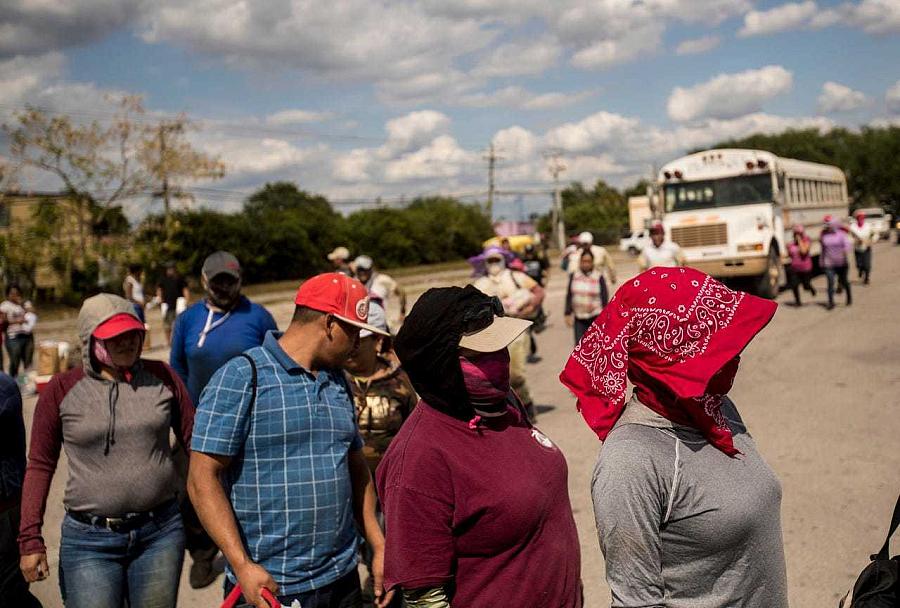We know how the pandemic is hurting Florida farmworkers. What about their kids?

(Photo by Andrew West/News-Press/Naples Daily News)
This past summer, as coronavirus cases spiked among Florida farmworkers, a doctor volunteering in Immokalee said that more than 50% of the tests he performed in the rural community were positive. He wrote in Salon that it “may be one of the highest community rates of coronavirus infection in the country — even in the world!”
The doctor was part of a mobilization effort after the Coalition of Immokalee Workers advocated for greater COVID-19 testing and protections for farmworkers.
Around the same time, I wrote a story about a farmworker who died two days after working in the fields. She worked for a grower who required masks, temperature checks and spacing on the old school buses that transport tomato pickers to fields. Despite the improved protocols, she contracted the virus, presumably through community spread.
Through reporting that story, I learned about testing and outreach for farmworkers but also how those efforts are complicated by factors including culture, language and crowded housing, particularly for undocumented workers barred from public housing. In other words, there are not simple solutions to preventing the virus in farmworker communities.
Florida farmworkers are critical to the economy. The agriculture they support is a robust link in the nation’s food chain. Florida oranges hold a $1 billion production value, 60% of the nation’s overall value, while its tomatoes are valued at $260 million, 34% of the nation’s value.
There has been media coverage on how the pandemic has hurt Florida farmworkers. But I have seen little reporting on the impacts to their children.
Florida counts 36,000 farmworker family households. Many children of farmworkers faced adversity and stress prior to COVID-19. How has the pandemic impacted pre-existing health, education and child welfare disparities? What has the pandemic changed about the children’s lives? To what extent have virus testing and educational resources reached them?
These are some of the questions I will seek to answer with my 2020 Data Fellowship. The route to answering those questions is not clear-cut.
An early research goal will be to figure out which Florida agricultural communities are facing the most crowded housing conditions and where the largest populations of farmworkers live. I’ll review existing government and academic studies on farmworker housing and federal and state data on demographics, socioeconomics and housing.
I first reported on overcrowded farmworker housing in Southwest Florida nearly 15 years ago. It’s been a problem for far longer than that. COVID-19 has highlighted the inability to distance in a household as a potentially life-or-death obstacle.
Housing to quarantine workers is not readily available in many communities. Advocates and growers have recognized this gap in the social safety net. At one point, in Immokalee, positive workers were isolated in a town 30 minutes away. An advocate told me some workers were reluctant to get tested for fear they would be forcibly separated from their families.
Much of the media coverage has centered on Immokalee, hub of the nation’s winter tomato crop and home to a strong advocacy network. It’s unclear how smaller farming communities, underserved by watchdogs, are faring. In Immokalee and beyond, what are the community and government plans to serve families with parents that must isolate and stop working?
Through interviews and data analysis, I’ll zero in on communities to study further. In those regions, I will review school and state health data.
There is a lack of precise COVID-19 pediatric data specific to ZIP codes.
However, I can look to county-level pediatric COVID-19 rates. Florida also releases school-level data on COVID-19 cases without identifying if the positive case comes from a student or staff member. That data will help me determine how the number of COVID-19 cases in schools in agricultural communities compares to schools elsewhere.
I will request attendance data too. How does school attendance in farmworker communities compare from early 2019 to during the pandemic? What are the current in-person versus virtual schooling rates in those schools?
The data analysis will inform critical interviews with parents and children.
There’s also the matter of government accountability to investigate. The state government was criticized by farmworkers and their advocates for its lagging response. There have been spotty efforts to provide government-funded testing and outreach. Through records requests, I will quantify to what degree those publicly funded resources have targeted or reached children.
I also wonder about access to virtual education and support. Are farmworker families receiving an equitable and culturally relevant share of publicly funded virtual education support and resources? How much money did school districts parse out to pandemic-related outreach to parents in federally funded migrant programs?
Answering those questions will require interviews and records requests.
I’ve compiled a list of other data sources to help answer child welfare questions related to abuse and neglect, food scarcity, family stress and pediatric mental health. I will also look for seasonal patterns in the data as farmworker families migrate north in the spring and summer and return to Florida in the fall and winter.
Along with analyzing the data, I will look for stories of resilience and successful collaborations. For instance, a migrant childcare organization has offered free COVID-19 testing for children. A behavioral health center has created a pandemic-related children’s book in multiple languages.
Coronavirus positivity rates in farmworker communities have declined since the summer surge. But thousands of migrant families are returning to Florida and there are still many unknowns. My goal with this fellowship is to fill in as many of those unknowns as I can.

